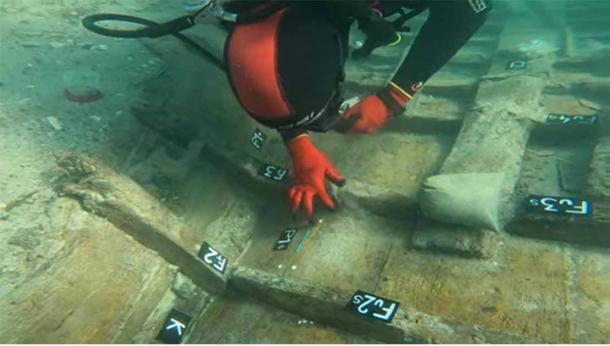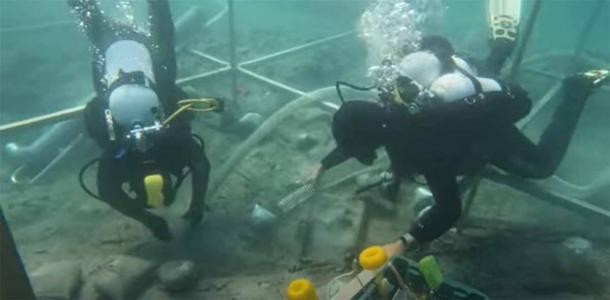
Full Shell of 2,000-Year-Old Roman Ship Discovered on Croatian Riverbed
Archaeologists working on the banks of the Zadar River at the Barbir site have stumbled upon a remarkable discovery that has come after 6 concerted years of research and labor – a 1st century Roman ship! It’s in great condition even though parts have been eaten away by shipworms, with the sand over 2 millennia acting as a preserver.
Remarkable Preservation of Both A Roman Ship and Pier
"The ancient port of Barbir was discovered in 1973 and for a long time was documented only superficially, thanks to the research of Boris Ilakovec. Only in 2017 did new, more serious work begin in that area, in parallel with the research of the Roman villa on the mainland, which was largely destroyed due to modern construction. Fortunately, part of the site under the sea has been well preserved", reveals Mladen Pešić, the leader of this research and the director of the International Centre for Underwater Archaeology (ICUA).
- Are Sea Creatures Really Eating Captain Cook’s “Endeavour”?
- Mysterious 40 Foot Latvian Shipwreck Unearthed On the Beach Near Riga

Extremely well-preserved timbers of the Roman ship in Croatia. (Slobodna Dalmacija / Zadarski)
Zadarski reports that assisting the ICUA were German Archaeological Institute, Oxford University, the University of Zadar, and the Archaeological Museum. Hidden beneath layers and layers of sand, the investigating team has uncovered 3 x 9 meters (9.8 x 29.5 feet) of the ship so far.
Collectively, they also investigated the structure of the Roman pier, which had been built over two distinct phases.
Two Phases of Pier Construction
Phase 1 dates to the 1st century AD, when the pier was relatively smaller and not as defined as the succeeding structure. To date this phase, archaeologists performed radiocarbon dating on ceramic vessels, amphorae, oil lamps and glass fragments.
The parent city of this port and site, Sukosan, received these items from different parts of the Mediterranean, including present-day Greece, Turkey, the Arabian Peninsula, and Italy, all important trade route networks. The trade route network also includes heavy links with Northern Africa, as evidenced from the finds.
The second phase was added on in the 4th century, leading to the formation of a ‘tongue shape’ that resembles the condition it was found in currently. With this too, the archaeologists are rather surprised as it defies the logic of preservation, remaining standing despite its proximity to the water, reports Total Croatia News.
- Ancient Sea Monster Discovered in Hull of King’s Ship
- Secrets of 829-Year-Old Post-Viking-Era Shipwreck Revealed
The Metal Nail That Hit its Mark
At the pier site, there have been finds from North Africa; 30 bronze coins from the reign of Constantine II, Constans and Constantius II were found in a layer 150 centimeters below the present-day seabed. Then about two years ago, the investigators found an intriguing board with a metal nail, which would usually be used in shipbuilding. To investigate this hunch further, they opened the first four squares of excavation in this location, each 4 square meters in size. This led them to the Roman ship.

The excavation area for the ship. (You tube Screenshot / Zadarski)
The ship was initially dated to the 2nd century, but later changed to the 1st century which tied in with the construction of the 1st phase of the port. Later, the GAI and the University of Zadar were brought in to help speed up the process, although it was not an expansive team. Since the ship was at a shallow depth of just 2 meters (6.56 feet), it allowed each of the two teams of divers to stay under water for almost 2 hours at a stretch, which greatly expedited the research process.
Pešić explained:
“With this research, we managed to reach half of the ship. Each element is marked, photographed, and based on that, we will later make the blueprints of the ship itself. Unlike most ancient ships that sink and end up deformed at the bottom of the sea, this one managed to keep its shape. Its entire shell has been preserved and that is a great special feature. We have sent samples from all wooden elements for analysis in France, and by determining the material, it will be known whether it is local production or production from other regions. Because a lot of materials originating from the entire Mediterranean, from Greece and Italy to Africa, have already been found in the port.”
Moving forward, the second half of the ship will be uncovered in a new phase of research beginning next year. The site will be protected by sand, geotextile, and stone, which will provide protection from the sea, like it has done until now. After this, the archaeologists hope to put up the ship on display in a museum, as Croatia’s cultural heritage hasn’t accommodated this aspect of their history so far.
Top image: Archaeological diver excavating the Roman ship at Barbir, Croatia. Source: Screenshot / Zadarski
By Sahir Pandey
References
Andelkovic, K. 2022. 2000 Years Old Roman Ship Discovered off the Coast of Sukosan near Zadar. Available at: https://www.total-croatia-news.com/lifestyle/65859-roman-ship.
CW. 2022. 2,000-year-old Roman boat discovered in sea off Sukošan in Croatia. Available at: https://www.croatiaweek.com/2000-year-old-roman-boat-discovered-in-sea-off-sukosan-in-croatia/.
Heritage Daily. 2022. UNDERWATER ARCHAEOLOGISTS UNCOVER 2,000-YEAR-OLD ROMAN SHIP. https://www.heritagedaily.com/2022/11/underwater-archaeologists-uncover-2000-year-old-roman-ship/145141.
Skrbic, A.V. 2022. A great discovery by Zadar archaeologists: a Roman ship from the 1st century surfaced in the sea near Sukošan! Available at: https://zadarski.slobodnadalmacija.hr/zadar/4-kantuna/sjajno-otkrice-zadarskih-arheologa-u-moru-kraj-sukosana-izronio-rimski-brod-iz-1-stoljeca-pogledate-senzacionalne-podvodne-snimke-s-nalazista-1237862.
















Comments
Seems they always want to date finds to fall into the ‘Roman era’ as if all that came before is non-existent, non-viable to have produced anything significant. A highly dubious tendency of theirs, which diverts from understanding the rich PRE-ROMAN culture of those villages and people that the Romans came to conquer and enslave.
Nobody gets paid to tell the truth.